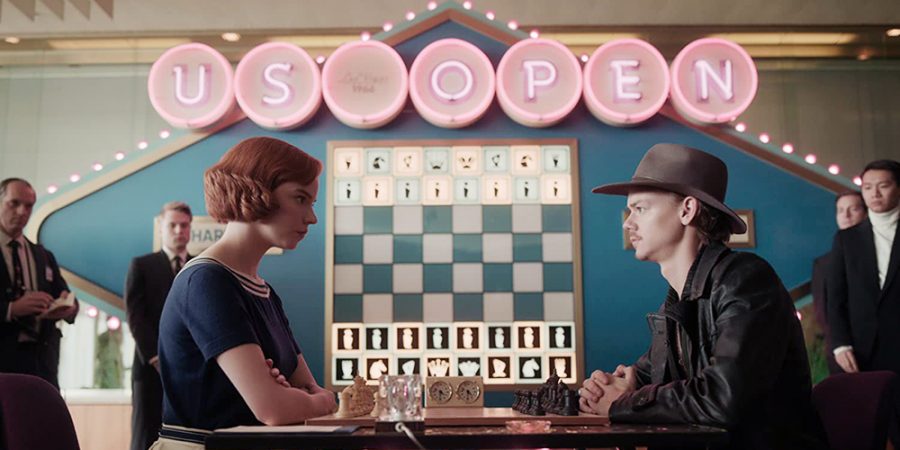‘The Queen’s Gambit:’ transforming the mundane into a cinematic wonder
Photo Credit: Netflix
“The Queen’s Gambit” delivers pleasing cinematography throughout the series, as depicted in this still moments before protagonist Beth Harmon and competitor Benny Watts play chess at the US Open.
March 9, 2021
Watching a televised chess match seems quite dull at first thought — two players glued to their chairs doing nothing but moving delicately crafted wooden pieces with precision across a checkered board. Besides the faint ticking of a chess clock placed upon the table, the game is soundless.
It’s a game that paints itself as lethargic to the average viewer, yet Netflix’s recent coming-of-age drama miniseries, “The Queen’s Gambit,” transforms the game of chess from a mundane activity into an enthralling story, coupled with emotive acting and cinematography.
The title alludes to the chess opening of the same name: one of the many “gambit” openings in chess where a piece is sacrificed in an attempt to gain a positional advantage. This opening comes to cleverly describe the fictional story of Elizabeth “Beth” Harmon, and the sacrifices she makes in hopes of becoming the greatest chess player.
Beth Harmon, played by Anya Taylor-Joy, stumbles upon her adroit chess abilities after playing chess with a janitor in the basement of Methuen Home, an orphanage where Harmon resided as a child. Harmon quickly becomes engrossed in the game and perfects her play, but with it arrives a dependency on drugs and alcohol. “The Queen’s Gambit” follows the ever so classic “underdog” trope and is almost predictable at moments, but it heavily succeeds in strong character development and utilizes cinematography and score to enhance the complexity of chess.
The show uses an array of shots that are pleasing to the eye and convey a respective message. One of the most prevalent shots that demonstrates this is the use of long takes. After arriving in Mexico City, Harmon enters a grand hotel lobby (actually filmed in the Friedrichstadt-Palast Theater in Berlin, Germany) where instead of multiple shots, the camera starts at Harmon’s ankles as she walks up the detailed stairs before panning upward to display the design and a glimpse of the guests and workers in this hotel. The camera continues upwards and to the right, before making its way back down to meet Harmon again — all in one long take. This long take slows down the story and previous fast-paced editing and does a great job of making the story quite literally follow Harmon’s journey. It plays a role in worldbuilding and establishing setting as we get to see spatial relationships and the layout of this charming hotel.
In contrast, the cinematography also adapts and adds cuts adequately, specifically during the actual chess matches. To have a long scene with no cuts in a chess match would simply be boring, but the cinematography creates a more exciting atmosphere. In a game against the arrogant Harry Beltik, a supporting character who is one of the best chess players in Harmon’s home state, Kentucky, close-ups of facial expressions were used to amplify the match. Beltik’s expressions exude confidence and boredom — at one point he literally yawns during the game while the camera focuses on his face. Beth is clearly bothered by this, with her stone-cold gaze and look of annoyance. The scene cuts back and forth between over-the-shoulder shots and up-close facial expressions, as well as a holistic look from the side at the spectators and Beltik and Harmon in the same frame. In addition to this, in certain chess matches in the show, the score mimics the different stages and climaxes of an actual game.
The cinematography and score no doubt exemplify “The Queen’s Gambit,” but the stand-out feature of the series is the very protagonist, Beth Harmon and her complex character, and Anya Taylor-Joy’s brilliant delivery of Harmon.
Harmon’s look itself is distinct: her red hair makes her easily stand out, even from her childhood with an awkwardly styled bob haircut. Taylor-Joy entices viewers with her iconic look and carefully portrays the nuanced personality of Harmon.
The story takes an in-depth look at Harmon’s life and relationships, tracing back to her non-sugar-coated childhood where key events shape Harmon into a mature adult with faults and strengths alike. Harmon develops an addiction to tranquilizer pills as a child and while at times this idea could be more developed, particularly near the end of the show where she suddenly hits “rock bottom” with her addiction, Harmon is complex in the sense that she was self-destructive and made sacrifices for chess. Her relationships with others were well-explored for the most part and allowed a display of her layered personality as she conversed with the janitor who taught her chess, her adoptive mother, other chess competitors, and classmates at school. The actors each embodied their characters with refreshing dialogue and expressions, some including young Beth, played by Isla Johnson, Benny Watts, a challenging chess competitor played by Thomas Brodie-Sangster, and most of all, Anya Taylor-Joy.
“The Queen’s Gambit” could have aligned Beth’s character with the concept of her “being a woman chess player struggling in a male-dominated game” — but it doesn’t. It purely focuses on her being a chess player and her troubled life. The show doesn’t have to villainize men in order to bring Beth up. In fact, Beth often befriends male chess competitors and they satisfyingly support each other in improving their skills. The show doesn’t make Beth a classic “damsel-in-distress” — but it also doesn’t make her an overly independent and aggressive character as “feminist” media will often do in an attempt to portray a strong female character. She accepts the help of others and is a character who breaks down from time to time, just as any human would. With Beth, there’s a balance between stereotypical “masculine” traits, while also embracing and not diminishing stereotypical “feminine” qualities. Her character is truly realistic and doesn’t rely on fixed gender roles, something media often fails at when creating female characters.
“The Queen’s Gambit” revitalized the game of chess, attracting viewers whether chess is a topic of interest or not. Through its stunning character development and plot, the show is definitely worth a watch — and perhaps a game of chess in the meantime.




